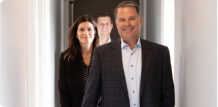Four years ago oil prices approached $150 per barrel. Analysts at Goldman Sachs got all in a lather, with one making the prediction that it would soon hit $200. Peak oil theory became a hot topic in the American press and our dependence on foreign oil both a national security interest and a polarizing issue on the political campaign trail. Fixed-price natural gas contracts sold like hot cakes at $10/mCF and funding for new wind and solar projects soared to new heights. If the United States didn’t soon receive treatment for its dangerous addiction to scarce fossil fuels, we would ultimately join Rome in the ranks of former world superpowers. (View a printable version of this Economic Update: Quirky Tales and Waves of Change).
Today, the change in the story line is striking. While the amount of fossil fuel buried in mother Earth has remained a very real constant throughout the past four years, new technology has provided access to natural gas and other rich liquids to such a degree that we are now perceived to have a glut which could keep prices at $3-5/mCF for the foreseeable future and perhaps even lower. The political debates have quietly shifted from a scarcity to an abundance mentality and the campaign trail may now be littered with debates over what we should do with all this stuff. Pipeline politics are entering the picture, and the prospects for funding new LNG export terminals a real possibility.
While the various forms of fossil fuels (coal, natgas, and oil) are not perfect substitutes for one another, over time, a glut in the supply of one will likely have a restraining effect on the prices of the others. Natural gas has been in an outright deflationary spiral for much of the past four years and in spite of the lower prices which would normally curtail production efforts, they have counter intuitively increased as anyone in Ohio readily knows. Coal pricing finally caught the natural gas pricing flu this spring, a trend which will likely continue as more utility companies convert to burning gas and as grassroot hobbyists tinker with their autos.
While almost all commodities (ag, chemicals, and energy) have tended to move up and down together in price, oil has always beat to a different drummer, likely as a function of the ebb and flow of geopolitical concerns and the physical location of most known reserves. I would guess, however, if natural gas is in such abundance domestically, it could very well be the case around the globe. The prospect for $200 oil might be as remote as NASDAQ 5000.
Despite the long introduction, I only mention the recent history surrounding the debate over the scarcity of fossil fuels to address another hot topic currently brewing on Wall Street. Some believe that American enterprise has reached peak productivity and earnings, therefore, can’t be far behind.
While it is certainly true that cost cutting measures – aka corporate austerity - have contributed to record profit margins and cash balances across corporate America, I also believe a subtle shift in consumer driven productivity has long been underway, one of which has set the stage for another generational shift in productivity and living standards.
Thanks to the Great Recession, companies have used the tough times to pare back and utilize corporate resources much more efficiently. Corporate America has trained hard, in a no pain, no gain style. As we emerge from our troubled days, I suspect we will be surprised at just how far we can go with much less effort than the past.
I fully acknowledge that the following personal anecdotes may not translate well within the classic framework of business economics, but when considered from a macro level they may nevertheless reveal Adam Smith’s invisible hand busy at work, painting the fresh outlines of a new and different economy.
Many years ago, Henry Ford quipped that had he listened to his customers, he’d have given them a faster horse. Pithy, to be sure, but with the benefit of hindsight, quite on the mark. Sergey Brin and Larry Page of Google could have said the same thing about their foray into the advertising business. But instead of giving us a better newspaper, they gave us the search engine.
While I am not quite sure how the new framework of consumer driven productivity advances can be quantified as to their overall impact on the economy, there can be no doubt that we’ve all experienced the benefits. To that point, I would like to share a few examples from my recent personal life that have helped me to learn more, experience more, and in a very real sense, live more. In a Thomas Jefferson style, we’re all able to do a lot more for ourselves than we once were, even just a few short years ago.
********
YouTube Mechanic
A few weeks ago, my zero turn Cub Cadet riding mower lost its power. Rather than sending it to the shop and being without a mower for a few weeks and knowing the manual would be of little help, I turned to Google and YouTube. I ended up watching a video which not only helped me change the oil in the hydraulic system, but also gave me some ideas on how to remove the stubborn original equipment oil filters. YouTube brought me in immediate touch with others who had shared my problem and overcome. After successfully changing the oil and learning how to purge the engine – whatever that means – I had the power back, so much so that I thought I had a brand new mower.
Of course, the story doesn’t end there because I quickly realized that there was a small leak in one area of the transmission. A few bolts surrounding a gasket area suggested that the threads might be stripped or at the very least were not that grippy. (Yeah, I’m no engineer, but experience did teach me some new words that at least I understand.) I called my brother who told me I could rethread the transmission block by purchasing a $20 kit from Autozone. With the help of another YouTube video, I was able to rethread the bolts and rule out that those were the problem. Ultimately, I still had to send it to the shop for transmission parts that weren’t available to end consumers (they must not be up to date with a Google world), but thanks to YouTube and advertising sponsorship from Google, I came very close to fixing the problem on my own.
Keeping Score
At my eight year old son’s first baseball game last night, a five inning affair that lasted three hours and ended in a 16-15 victory on just eight hits, I was nominated to keep score. I didn’t know much about the process of keeping a score sheet, but I guess I knew more than the other guys, presumably because my son plays high school ball.
Keeping score for a baseball game, I knew, was a little like scoring in bowling. Instead of coloring in the square for a strike, you just needed to do the same for the diamond when a runner came home. Needless to say, it was much more complex than that. Perfectly done, a novice should be able to completely reconstruct the flow of an entire nine inning game by looking at the score sheet – balls, strikes, bases, runs, errors – the whole shebang.
Yeah, I failed.
Somehow, I had missed out on the fine art of scoring a baseball game during my childhood. Knowing that I needed to do a better job at the next game and that none of the other dads would likely be able to offer me much help, I turned to my iPad for answers. By Googling “how to keep score in baseball”, I found several tutorials on how to keep score, including the very first result, a play by play lesson from my favorite website of all time – theartofmanliness.com. While finding it there certainly made me feel less manly, I think I grew a few new chest hairs for manning up to my inadequacies. I’ll even bet there’s an App for that – for scoring ball – but since I don’t want to ruin a perfectly good iPad with a random foul ball, I plan to stick with paper and pencil for Saturday’s big game.
Catchy Tunes on SNL
Two nights ago, I sat down to watch a few episodes of my favorite television shows on DVR. After catching up on Fringe, American Pickers, and Top Shot, I settled into the most recent episode of Saturday Night Live. Gotye was the show’s musical guest and their catchy tune “Somebody That I Used to Know” still rings in my head. Not only did I buy the song on iTunes, I also watched the video for free on YouTube.
Wanting to learn more about the artist, I googled him and found a video describing the inspiration behind another older hit he has called Eyes Wide Open. Visiting Musical Fence – a place that could best be described as an outdoor amusement park of primitive musical instruments in the Outback of Australia - Gotye sampled a number of sounds from a variety of objects from barbed wire fences to trash can lids to develop the base sound for what would later become this hit. Coupled with his interest in animation, it was a fascinating clip and a fun video to watch.
Social Media
Today, Kathleen – an associate at Broadleaf – mentioned that her kids had been involved in a side conversation about teenage promiscuity and pregnancy. While the kids took this discussion in stride, what took Kathleen by surprise was the fact that they were very disturbed by another conversation on teenage smoking. In our day, kids smoked as a social activity and many high schools even permitted students time to take a smoke break in the “pit” with teachers. At one time, smoking was a commonplace and accepted social activity, like eating lunch in the cafeteria.
This conversation got me thinking more about social networking. Facebook’s whole premise as a business is based on the notion that what becomes popular or widely accepted is often established via social circles. Let’s face it, wearing Ugg Boots and Yoga Pants to class while humming the fascinating lyrics of Nicki Minaj really isn’t all that cool, but because the social circle says it is, it is. (Smoking and mullets were similarly cool in my day and age for anyone who might disagree.)
Speaking of social media, I also learned that Gotye, though composing for more than ten years, didn’t really get noticed on the international scene until Ashton Kutcher gave his music a positive nod in the Twittersphere. In a similar nod to the productive power of the social network, Nike, I recently read, has significantly curtailed its advertising contracts with many high profile athletes in recent years in favor of social media relationships with its customers or natural “fans” as it calls them. I guess the effective but high cost influence of professional athletes has become as much of a liability as a benefit given recent public relationship nightmares with Tiger Woods etal.
Not only are social media circles just as powerful in generating support for established brands like Nike, but it may also be a cost effective enabler of establishing new brands in the market. While there are certainly cost advantages to having your natural fans pump your product for you, social media has also shown the top line value of having your product go viral, as recently illustrated by the experience of new razor blade company, The Dollar Shave Club. The use of social media by companies like Nike not only shows how costs can be lowered, but also shows how new brands like The Dollar Shave Club can challenge even the most entrenched competitors like Gillette and Schick to drive top line results for new entrants and bottom line value for consumers.
********
During the dot com boom, many companies went into business and ultimately failed, as was the case for the early automobile industry. While the ultimate winners in the industry were not known early on in their histories, Ford and Google, among a select other few have proven that the industries were game shifting and here to stay.
Many employees of American business still commute far distances on a daily basis to their places of employment. A great deal of time is lost caught up in traffic jams for the sake of maintaining the status quo, or as I’ll put it, the way of the horse. I wear a suit and tie when meeting with clients, but I don’t believe for a minute that wearing one improves my stock picking ability.
In the day and age of telecommuting, I suspect more companies could consider the telecommuniting option as a form of compensation to employees and I’ll bet productivity on both sides of the equation would benefit. Workers would save time, which is money, companies would save on real estate and perhaps compensation costs, and circling back to my introductory comments, we’d all use less gasoline. I for one, consider my ten minute commute to work a definite fringe benefit of the job, but at the same time, here I am at 11pm, completing this update. I get things done when I can, shifting time to meet the needs of my family and our business.
Recently I came across an interesting survey I found on Google. Faced between choosing a driver’s license or an internet connection, today’s youth would largely prefer the latter, which should be a scary thought for today’s automobile companies. I don’t believe it’s fair to suggest that this is a generation of teenagers at risk of losing their social skills. To the contrary, I’ve never seen kids so in touch with one another via text messages, Facetime, and Skype chats. Frankly, I don’t know how my thirteen year old daughter can carry on conversations for so long. I also remember when email first came out. People were scared to death that it wasn’t secure and could be stolen. Scott McNealy of Sun Microsystems was quick to remind us that email was no less secure than the mailbox at the end of our driveway.
Google recently published a YouTube video of a self-driving car taking a partially blind man on a five mile ride. The prototype uses Google Maps, satellite, radar, and lasers to the five miles and even takes him to Taco Bell. While it’s a very early concept that clearly needs to see improvements – Chipotle would be a much better choice – it still paints a promising vision of where we may be headed and meshes with the idea that kids these days would rather be texting than driving if given a choice between the two.
The end of American productivity is not near; it simply is yet to be imagined. As I look at my life, I can sense immense, positive change on the horizon, change that cannot and will not be derailed as long as humans are free to exercise their minds and come up with new solutions to everyday problems.
Scarcity is a figment of our imagination.
And now is America’s time to shine.
Kindest Regards,
Doug MacKay, CEO & CIO
Bill Hoover, President



